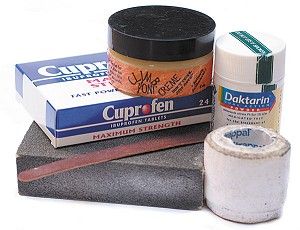
The following article is based on text from the book Sport CLIMBING + published by Rockfax. This article version was written by Adrian Berry.
The abrasive nature of the rock combined with the moisture-absorbing properties of chalk will dry your skin out. When your skin is dry it is more prone to wear and cuts. As soon as you finish climbing, wash your hands and use a skin moisturiser as often as possible. Creams with healing vitamin E and a moisturiser can be be bought at any chemist. The best creams contain Shea butter. Popular are CLIMB ON's creams and bars, SYPELAND's Climbers' Balm and PALMER'S Cocoa butter.
Cuts and flappers
Minor cuts should be cleaned and in most cases covered with finger tape. If you do continue climbing, the cut may open up and take even longer to heal. Keeping the cut moisturised will help prevent it cracking if you climb, though it is often better to take a rest day and await healing.
Flappers (or avulsions) are a more serious proposition. This is where a thick flap of skin rips usually due to much pressure on a sharp hold, quite often when it is cold and your skin isn't as sensitive. The end result is a lot of blood, a gaping hole and a flap of skin that makes further climbing impossible. In the old days an assortment of remedies were used to enable us to continue climbing, including the use of superglue (a carcinogen) to stick the flapper back. The risk of infection is great with a deep flapper, so it is best to wash with disinfectant, cover in gauze and await healing.
Calluses
As you climb you put repeated pressure and friction on the skin of your fingers. The skin responds by growing areas of thickened skin or calluses. Calluses are quite natural, but heavily callused skin is more prone to flappers. Treat it by filing down the callus then moisturising. The best tool for filing down your skin is a sanding block (a block of foam covered in fine sandpaper).
Worn skin
A large volume of climbing, especially on rough rock, will remove layers of skin from your tips until they are sore, sweat easily and even bleed. Typically, worn skin will leave an abrupt 'step' between skin layers, this will tend to roll if you climb on it, making things worse. Treat this skin step by filing it down so that there is no edge to catch and moisturise when you are not climbing.
Taping
If you must climb with broken or worn skin, use finger tape to cover the injury whilst climbing. The trick is to ensure your tape doesn't slide off. Use one piece of tape along the front and back of the length of your finger, then with a very thin length of tape, encircle your finger with overlapping turns. If you work outwards along your finger, the edges of the tape can catch on the rock, giving you a bit more 'stick' (cheating)! Wrapping the other way gives less stick, but the tape will stay on much longer so choose this for long or multi-pitch routes.
Foot care
The first step in looking after your feet is getting a well-fitting pair of climbing shoes . High-performance climbing shoes are very anatomical, with curved and asymmetric soles and rands that pull. While they do need to be snug, if you get a pair that is too tight they will impede your performance and also encourage, calluses, bunions and corns.
Fitting climbing shoes
- Cut your toe nails straight and short - but not too short.
- Make sure the fit is comfortable and snug, but not overtight.
- Manufacturers foot lasts vary, some are narrow at the heel or at the toe, some have a small volume compared to others. Try on several brands and models until you find the right fit. If you are a male with a narrow foot try a woman's shoe for fit.
- Unlined shoes will stretch up to a full size and can be fitted tighter than lined shoes which will hardly stretch at all.
To avoid the smelly-rock-shoe syndrome and prolong the life of your shoe, only wear climbing shoes when actually climbing.
Take a pair of flip-flops to wear between routes. This will rest and air your feet.
Store your shoes in a dry airy place to dry out. Consider placing a natural aromatic cedar block in them which absorbs moisture and unpleasant odours and contains a natural fungicide.
Like callused hands, feet also benefit from application of a moisturising cream and sanding down over callused areas on a regular basis.
Preventing athlete's foot
Many people carry fungus on their skin, however, it will only flourish to the point of causing athlete's foot if conditions are right. The fungus grows best in moist, damp, dark places with poor ventilation, i.e. in your climbing shoes.
- In addition to only wearing your shoes when on a route also:
- Wash your feet daily and dry them thoroughly afterwards.
- Go barefoot outdoors when possible.
- Wear cotton socks and change them often if they get damp.
- Use a good quality foot powder.
Sport CLIMBING +
The Rockfax book Sport Climbing + includes many more useful tips like this which will help you climb better and safer. For example, have you ever wished to know how to get down from mid-route by abseiling off a single bolt without threading it or losing any gear?
The book is not just about rope techniques though. There are chapters on technique, onsighting, redpointing, the mind, training, mutli-pitching, self-care and destinations.

















Comments